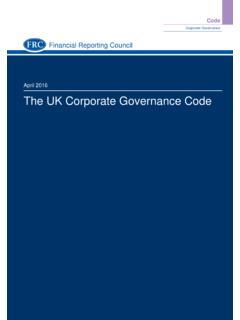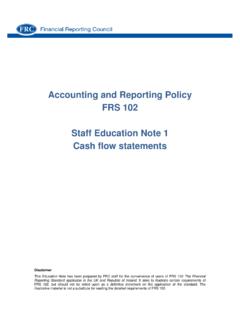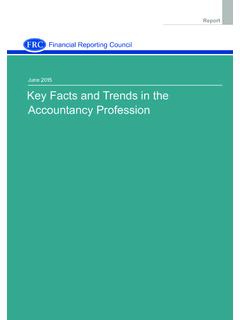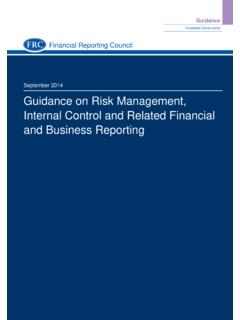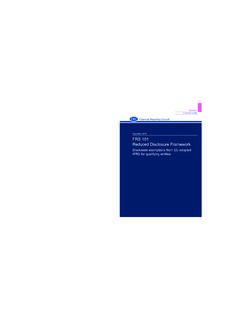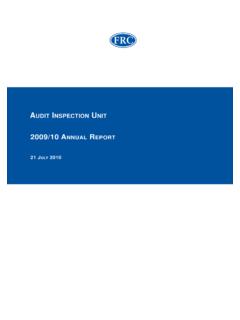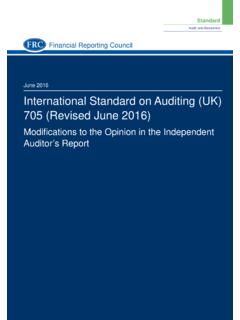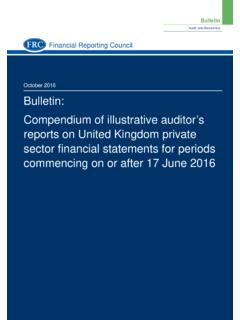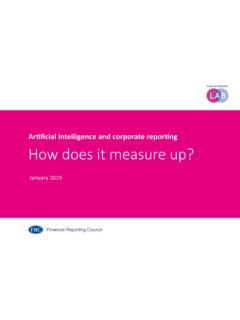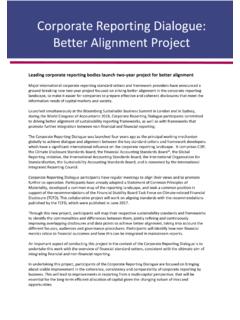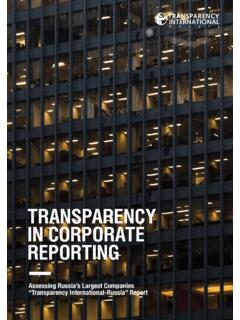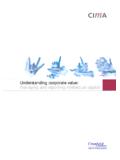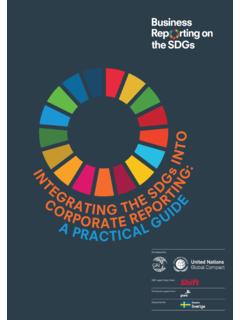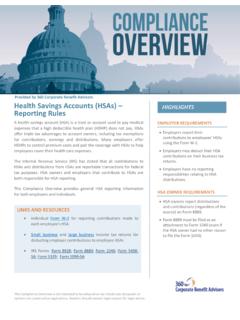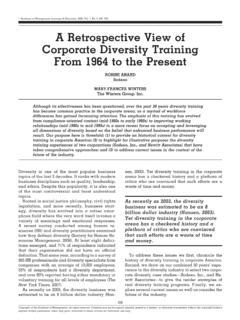Transcription of Corporate Reporting Review - frc.org.uk
1 Corporate Reporting ReviewTechnical Findings 2017/18 October 2018 Financial Reporting Council Technical findingsContentsIntroduction1 Judgements and estimates2 Alternative performance measures (APMs)9 Strategic report13 Income taxes15 Revenue recognition16 Business combinations17 Impairment17 Pensions18 Cash flow statements19 Provisions19 Financial Reporting Council Technical findingsIntroductionThis document highlights the matters more frequently identified by the FRC s Corporate Reporting monitoring activities, as conducted by its Corporate Reporting Review ( CRR ) function. It highlights the top 10 areas where the FRC asked questions of preparers relating to reports reviewed in the year to March 2018 and builds on the themes identified in the Annual Review of Corporate Governance and Reporting 2017/18 ( annual report ).
2 Particular focus has been given to the top three areas identified by CRR s work, two of which, judgements and estimates, and the use of alternative performance measures, were the subject of thematic reviews published in 2017. These issues, together with the Strategic Report, represent approximately one third of the total questions asked by CRR during the year. We expect preparers to reflect on these findings, and consider what improvements can be made to their Reporting . We have used a to highlight the most important s top 10 areas of questioning1. Judgements & Estimates2. Alternative Performance Measures (APMs)3. Strategic Report4. Income Taxes5.
3 Revenue6= Business Combinations6= Impairment of Assets8= Pensions8= Statement of Cash Flows8= Provisions and ContingenciesFinancial Reporting Council Technical findingsJudgements and estimatesThe FRC published its thematic Review on judgements and estimates in November 2017, highlighting a number of examples of good practice and identifying areas for improvement. The aim of the judgements and estimates disclosure requirements of IAS 1 is to inform users of the most subjective judgements, and the significant sources of estimation uncertainty that have a significant risk of resulting in a material adjustment to the carrying value of assets or liabilities in the next financial year.
4 The better examples we saw identify a small number of significant areas, and provide sufficiently granular information to understand the judgement, or the source of estimation uncertainty, and its effect on the also questioned disclosures where preparers failed adequately to distinguish between judgements and estimates, or where their usefulness was limited by inclusion of estimates where there was no significant risk of material adjustment in the next following slides highlight the different disclosures required for judgements and estimates, illustrate our expectations of good disclosures using a before and after comparison of common issues, and identify common findings.
5 We encourage all preparers to Review the thematic Review findings, which are consistent with our findings from our regular full scope reviews. relating to estimates specified by standards other than IAS 1, such as impairment disclosures (IAS 36), were generally of a higher standard than those where no such specific requirements apply. In some cases, in particular, estimates relating to uncertain tax positions, we challenged the absence of disclosures required by IAS 1 125-129. Financial Reporting Council Technical findingsDisclose information such that a user can understand the specific judgement, why it is significant, and how that conclusion has been reached ( )Does the source of estimation uncertainty have a significant risk of material adjustment to carrying value in the next year?
6 (IAS )Disclose the nature of uncertainty and carrying amount (IAS ) sufficient information for users to understand judgements about sources of estimation uncertainty, for example sensitivity analysis and ranges of outcomes (IAS )Does the disclosure relate to a judgement that has a significant effect on the amounts recognised in the financial statements (IAS )?What is it that I want to disclose?YesA judgement, other than one involving estimation, about how the entity has applied accounting policies?An assumption, or other source of estimation uncertainty (including judgements involving estimation)?YesNoNoConsider whether these disclosures are required. If an entity chooses to disclose explain clearly why the additional information has been provided and any related timescales Financial Reporting Council Technical findingsExample -Extracts from the Annual Report for the year ended 201 XSignificant judgements and estimates Significant judgements, estimates and underlying assumptions are reviewed on an ongoing basis.
7 Revisions to accounting estimates are recognised in the year in which the estimate is revised and in any future years affected. In applying the Group s accounting policies described above the Directors have identified that the following areas are the key judgements and estimates thathave a significant impact on the amounts recognised in the financial statements. Lease classificationThe classification of leases as either operating or finance leases is a key area of judgement. Leases are treated as finance leases where they transfer substantially all the risks and rewards of ownership to the of Goodwill The Group determines whether goodwill is impaired at least on an annual basis.
8 This requires an estimate of the value in use of thecash generating units to which the goodwill is allocated. To estimate the value in use, the Group estimates the expected future cash flows from the cash generating unit and discounts them to their present value at a determined discount rate, which is appropriate for the territory where the goodwill is allocated to. Forecasting expected cash flows, and selecting an appropriate discount rate inherently requires estimation. A sensitivity analysishas been performed over the estimates (see Note A). Note A. Goodwill (extract)A reduction of 10% in the forecast cashflows for each CGU from year 2 to 5 or an increase in the discount rate applied to the cashflows of each CGU of 1 percentage point would not cause the carrying value to exceed its recoverable amount for any , management believe that no reasonably possiblechange in the key assumptions would result in an impairment charge.
9 Before : disclosures in the year reviewedIf there is no reasonable possibility of an adjustment to carrying values, why are these considered to be key estimates?Boilerplate language simply repeats wording in the standard, and does not explain the precise nature of the judgementNo clear distinction is made between judgements and estimates in the following textThis wording does not reflect the requirements of IAS 1 for sources of estimation uncertainty a significant risk of material adjustment in the next financial yearFinancial Reporting Council Technical findings Before : disclosures in the year reviewedBoilerplate language used does not specify the precise areas of estimation for the Group, or quantify the amounts at risk of material adjustment, or provide any sensitivity analysisExample continued -Extracts from the Annual Report for the year ended 201 XEmployee Post Retirement Benefit Obligations The Group had two defined benefit pension plans, Scheme A and the Scheme B.
10 Scheme A was settled during the year through an insurance buy-out arrangement. The final present value of the obligation was calculated by independent actuaries as at the buy-out date, with input from management, in accordance with the Group s usual approach as outlined below. Further details of the buy-out can be found in Note C. The obligations under these plans are recognised in the Balance Sheet and represent the present value of the obligations calculated by independent actuaries, with input from management. These actuarial valuations include assumptions such as discount rates, return on assets, salary progression and mortality rates. These assumptions vary from time to time according to prevailing economic and social conditions.

